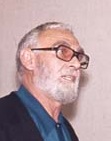
Back چورج اوتيزا ARZ Jorge Oteiza Breton Jorge Oteiza Enbil Catalan Jorge Oteiza German Jorge de Oteiza Spanish Jorge Oteiza Basque Jorge Oteiza French Jorge Oteiza Italian ホルヘ・オテイサ Japanese Jorge Oteiza Dutch
You can help expand this article with text translated from the corresponding article in Spanish. Click [show] for important translation instructions.
|
Jorge Oteiza | |
|---|---|
 | |
| Born | Jorge de Oteiza Embil October 21, 1908 |
| Died | April 9, 2003 |
| Known for | Sculpture, architecture, and writing |
| Movement | Equipo 57, Gaur, Land art |
| Awards | Prince of Asturias Award for the Arts |
Jorge Oteiza Enbil (October 21, 1908 – April 9, 2003), was a Basque Spanish sculptor, painter, designer and writer from the Basque Autonomous Community, renowned for being one of the main theorists on Basque modern art.[1][2] Oteiza was born in Orio (Gipuzkoa, Basque Autonomous Community, Spain).[2] He moved to South America in 1935, just before the Spanish Civil War, and stayed there for 14 years.[3] In 1963 he published Quosque tandem!, an essay about the aesthetics inherent to Basque soul, based on prehistoric art found in Basque regions and Basque people's anthropological roots.[4] Three years on, he contributed to found the artistic group Gaur.
He died in San Sebastián, Gipuzkoa, in 2003.[2] Following his will, a month after his death a museum dedicated to his career was opened in Alzuza, Navarre, in the place where he had lived since 1975. The Oteiza Museum is a monographic exhibition space housing the personal collection of Jorge Oteiza, which includes 1,690 sculptures, 2,000 experimental pieces from the artist's Chalk Laboratory, and an extensive collection of drawings and collages.[5]
- ^ Grace Glueck (2005-07-08). "'Emptying' Sculpture to Make Room for Spiritual Energy". The New York Times. Retrieved 2010-03-02.
- ^ a b c Zallo, Ramón (2007). Basques, today. Alberdania. p. 144. ISBN 978-84-96643-59-8.
- ^ de Oteiza, Jorge; Zulaika, Joseba (2003). Oteiza's selected writings. University of Nevada Press. p. 12. ISBN 978-1-877802-43-0.
- ^ Oteiza; Zulaika (2003), p. 286
- ^ "Oteiza Museum: General Information," from the Oteiza Museum's website. Retrieved 2010-11-08.
© MMXXIII Rich X Search. We shall prevail. All rights reserved. Rich X Search